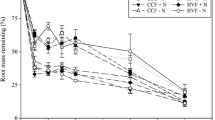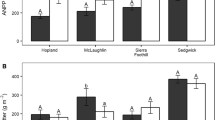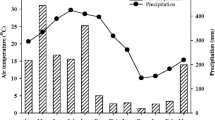Abstract
Background and aims
Plant nutrient uptake from coarse soil (2–4 mm diameter) has been demonstrated for only a limited number of nutrients, and the nutritional contribution of coarse soil when present with fine soil (material <2 mm diameter) in realistic ratios is unknown. We conducted a seedling pot trial to investigate the functional relevance of this soil fraction to plant nutrition.
Methods
Fine soil was mixed with either coarse soil, or the equivalent volume of inert glass chips, in ratios identical to those occurring naturally in soil sampled from two depths at each of two sites. Seedlings of Nothofagus solandri var. cliffortioides and Weinmannia racemosa were planted in the soil mixtures and harvested after 9 months.
Results
The content of nitrogen, phosphorous, potassium, magnesium and other elements in the above ground seedling tissue was significantly increased by the presence of coarse soil. The coarse soil fraction also contributed proportionally much more to plant nutrient uptake than fine soil on a mass per mass basis.
Conclusions
Coarse soil is excluded from conventional soil analysis, so is possible that soil nutrient capital is systematically underestimated. This has implications for land management and studies of plant dynamics in relation to nutrient supply.


Similar content being viewed by others
References
Ågren GI, Franklin O (2003) Root:shoot ratios, optimization and nitrogen productivity. Ann Bot 92:795–800
Augusto L, Ranger J, Turpault M-P, Bonnaud P (2001) Experimental in situ transformation of vermiculites to study the weathering impact of tree species on the soil. Eur J Soil Sci 52:81–92
Bakker MR, George E, Turpault M-P, Zhang JL, Zeller B (2004) Impact of Douglas-fir and Scots pine seedlings on plagioclase weathering under acidic conditions. Plant Soil 266:247–259
Blum JD, Klaue A, Nezat CA, Driscoll CT, Johnson CE, Siccama TG, Eagar C, Fahey TJ, Likens GE (2002) Mycorrhizal weathering of apatite as an important calcium source in base-poor forest ecosystems. Nature 417:729–731
Canham CD, Berkowitz AR, Kelly VR, Lovett GM, Ollinger SV, Schnurr J (1996) Biomass allocation and multiple resource limitation in tree seedlings. Can J For Res 26:1521–1530
Certini G, Campbell CD, Edwards AC (2004) Rock fragments in soil support a different microbial community from the fine earth. Soil Biol Biochem 36:1119–1128
Dickie IA, Richardson SJ, Wiser SK (2009) Ectomycorrhizal fungal communities and soil chemistry in harvested and unharvested temperate Nothofagus rainforests. Can J For Res 39:1069–1079
Garver JI, Kamp PJJ (2002) Integration of zircon color and zircon fission-track zonation patterns in orogenic belts: application to the Southern Alps, New Zealand. Tectonophysics 349:203–219
Hawkins BJ, Xue J, Bown HE, Clinton PW (2010) Relating nutritional and physiological characteristics to growth of Pinus radiata clones planted on a range of sites in New Zealand. Tree Physiol 30:1174–1191
Heisner U, Raber B, Hildebrand EE (2004) The importance of the soil skeleton for plant-available nutrients in sites of the Southern Black Forest, Germany. Eur J Forest Res 123:249–257
Hewitt AE (1992) New Zealand soil classification. Department of Scientific and Industrial Research Land Resources, Lower Hutt
Jobbágy EG, Jackson RB (2001) The distribution of soil nutrients with depth: global patterns and the imprint of plants. Biogeochemistry 53:51–77
Jongmans AG, Van Breemen N, Lundström U, Van Hees PAW, Finlay RD, Srinivasan M, Unestam T, Giesler R, Melkerud P-A (1997) Rock-eating fungi. Nature 389:682–683
Kirsten WJ, Hesselius GU (1983) Rapid, automatic, high capacity Dumas determination of nitrogen. Microchem J 28:529–547
Knops JMH, Tilman D (2000) Dynamics of soil nitrogen and carbon accumulation for 61 years after agricultural abandonment. Ecology 81:88–98
Koele N, Hildebrand EE (2008) The ecological significance of the coarse soil fraction for Picea abies (L.) Karst. seedling nutrition. Plant Soil 312:163–174
Koele N, Storch F, Hildebrand EE (2011) The coarse-soil fraction is the main living space of fungal hyphae in the BhBs horizon of a Podzol. J Plant Nutr Soil Sci 174:750–753
Lilienfein J, Qualls RG, Uselman SM, Bridgham SD (2004) Adsorption of dissolved organic and inorganic phosphorus in soils of a weathering chronosequence. Soil Sci Soc Am J 68:620–628
Mehlich A (1984) Mehlich 3 soil test extractant: a modification of Mehlich 2 extractant. Commu Soil Sci Plant 15:1409–1416
NIWA (2013) New Zealand National Climate Database, National Institute of Water and Atmosphere Research. http://cliflo.niwa.co.nz (accessed July 2013)
Platt KH, Allen RB, Coomes DA, Wiser SK (2004) Mountain beech seedling responses to removal of below-ground competition and fertiliser addition. N Z J Ecol 28:289–293
R Development Core Team (2012) R: a language and environment for statistical computing. R Foundation for Statistical Computing, Vienna
Turner BL, Lambers H, Condron LM, Cramer MD, Leake JR, Richardson AE, Smith SE (2013) Soil microbial biomass and the fate of phosphorus during long-term ecosystem development. Plant Soil 367:225–234
Ugolini FC, Corti G, Dufey JE, Agnelli A, Certini G (2001) Exchangeable Ca, Mg, and K of rock fragments and fine earth from sandstone and siltstone derived soils and their availability to grass. J Plant Nutr Soil Sci 164:309–315
van Schöll L, Kuyper TW, Smits MM, Landeweert R, Hoffland E, Breemen NV (2008) Rock-eating mycorrhizas: their role in plant nutrition and biogeochemical cycles. Plant Soil 303:35–47
Vierheilig H, Coughlan AP, Wyss U, Piché Y (1998) Ink and vinegar, a simple staining technique for arbuscular-mycorrhizal fungi. Appl Environ Microbiol 64:5004–5007
Vitousek PM, Farrington H (1997) Nutrient limitation and soil development: experimental test of a biogeochemical theory. Biogeochemistry 37:63–75
Wang JG, Zhang FS, Cao YP, Zhang XL (2000) Effect of plant types on release of mineral potassium from gneiss. Nutr Cycl Agroecosyst 56:37–44
Wardle P (1977) Plant communities of Westland National Park (New Zealand) and neighbouring lowland and coastal areas. N Z J Bot 15:323–398
Whitney N, Zabowski D (2004) Total soil nitrogen in the coarse fraction and at depth. Soil Sci Soc Am J 68:612–619
Wiser SK (2001) Exotic plants in Nothofagus forests managed sustainably for timber production in New Zealand. In: Stewart GH, Benecke U, Hickey J (eds) Sustainable management of indigenous forest: proceedings of the Southern Connections Congress III. Wickliffe Press, Christchurch, pp 88–95
Wiser SK, Allen RB, Benecke U, Baker G, Peltzer D (2005) Tree growth and mortality after small-group harvesting in New Zealand old-growth Nothofagus forests. Can J For Res 35:2323–2331
Acknowledgments
The authors thank Alan Leckie, Jessica Kerr and Kirsty Trotter for their assistance with the establishment and maintenance of the trial. We thank Katrin Webb (née Walbert) and Hayley Ridgeway for their advice regarding the examination of mycorrhizal colonization on the seedling roots. The helpful comments of the two anonymous reviewers were much appreciated. Funding for this work was provided by Landcare Research (programme C09X0802 “Sustainable Indigenous Forestry”) and Scion (Established Researchers Fund).
Author information
Authors and Affiliations
Corresponding author
Additional information
Responsible Editor: Benjamin L. Turner.
Rights and permissions
About this article
Cite this article
Smaill, S.J., Clinton, P.W., Allen, R.B. et al. New evidence indicates the coarse soil fraction is of greater relevance to plant nutrition than previously suggested. Plant Soil 374, 371–379 (2014). https://doi.org/10.1007/s11104-013-1898-3
Received:
Accepted:
Published:
Issue Date:
DOI: https://doi.org/10.1007/s11104-013-1898-3




